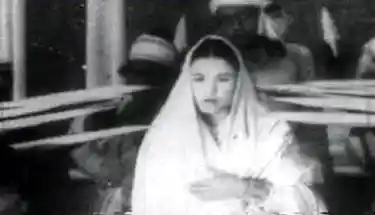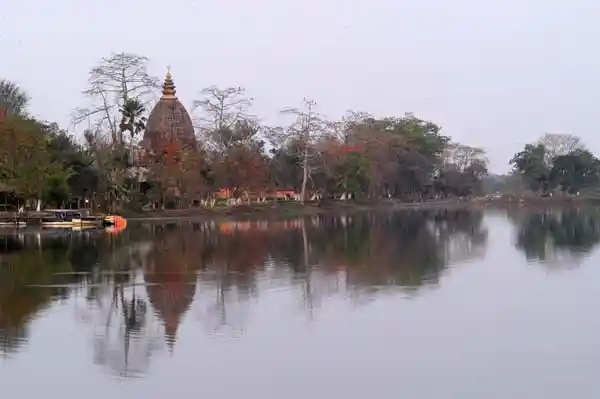Sticks and Stones may break her bones, but not her will
For fourteen days she endured torture. For fourteen days, her courage burned her enemies like wild fire. The old saying that ‘behind every successful man, there is a woman’ proves to be quite true in the case of Joymoti. In yet another lost tale from the northeast, we introduce this legendary figurine from the medieval times, whose story shaped the future of Assam, both politically and culturally.

Aideu Handique, the first Assamese actress as Joymoti in Jyotiprasad Agarwala’s movie. Source: Assamonline
The legendary ‘Rupkonwor’ of Assam, Jyoti Prasad Agarwala, is not merely revered for his contribution to Assamese prose and poetry. Additionally, he is also regarded as the torchbearer of Assamese cinema, for his masterpiece, Joymoti (1935). The making of Joymoti, a female centric movie, was radical not only in the northeast, but even in the larger context of India.
Joymoti celebrates the story of an unsung hero of Assam, a hero whose self sacrifice helped in bringing the much needed peace and stability during a tumultuous period of the Ahom Kingdom.
The years between 1671 and 1681 witnessed severe unrests in the Ahom Kingdom. During this period, many inept kings sat on the Ahom throne, who were no more than mere puppets at the hands of a powerful class of nobility. Our central figure, Joymoti, also lived during this period of instability.
Joymoti was married to Godapaani Gohain (later known as Gadhadhar Singha) of the Tungkhugia family. Godapaani had, since his early days, displayed both the passion and the skills to become a leader of the Ahoms during these trying times. The fact that he was a descendent of the Ahom founder, Sukaphaa, made him a powerful contender to the Ahom throne. However, his popularity became a threat to the reign of the boy king or ‘Lora Roja’, Sulikhphaa, who was effectively manipulated by the nobles in his court to kill any contenders to the throne.
Fearing that Godapaani might meet a similar fate as the other Ahom princes, Joymoti sent her husband into hiding. When the boy king’s ministers failed to find the missing Godapaani, they summoned Joymoti to ask her about her husband’s whereabouts. But Joymoti refused to give any answers. In response, the ministers, including the evil Prime Minister, Laluksala Borphukan, took her to *‘*Jerenga Pothar’ in Sivasagar and began subjecting her to inhumane treatment. They believed that a little torture would surely break down Joymoti.
Little did they know that the woman had a will harder than steel. She refused to betray her husband, who, she believed, was the key to restoring peace in the morally degrading Ahom kingdom.
Joymoti’s resolve and courage angered the ministers who continued to physically abuse her. Tied to a Kotkora gos (a thorny plant), Joymoti received constant lashings from her perpetrators that gradually increased in intensity. For fourteen days, the cycle of torture went on. Finally, after fourteen days her endurance reached its limit.
On 27th March, 1680 AD, Joymoti Konwori breathed her last, without getting a glimpse of the peaceful Assam that she dreamt about during her life. But her sacrifice did not go in vain. Joymoti’s dream was realized when Godapaani usurped the throne in 1681 AD, reviving the greatness of the Ahoms, once again.
In the end, Joymoti’s self- sacrifice was not merely an act of loyalty towards her husband. She died fighting for a bigger cause – to save her people and motherland from years of tyranny and turmoil.
Assam remembers Joymoti as the epitome of endurance and patriotism, and celebrates her courage every year on 27th March, as Sati Joymoti Divas. The Joysagar lake, built by Joymoti’s son, Rudra Singha, at the site of Jerenga Pathar, also serves as the memory of this heroic woman.
Hence, Jyoti Prasad Agarwala’s cinematic debut, Joymoti, serves more than just one purpose. On one hand, it led to the foundation of Assamese cinema, thus shaping the culture of modern Assam. On the other hand, the very portrayal of a woman in a leading role, was quite novel as ‘public’ women were looked negatively by the society during this time. Additionally, the movie ensured that the historic tale of Joymoti Konwori, the brave and patriotic woman, was heard and seen by the masses, rightfully so.

The Joysagar lake, built in memory of Joymoti by her son, Rudra Singha. Source: Online Sivasagar


